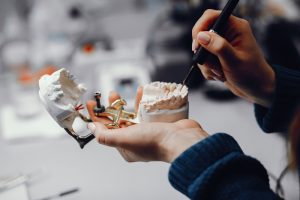Table of Contents
What is Dental X-Ray?
Dental radiographs or Dental X-rays are used to diagnose the oral health of children, adolescents, adults and those persons who need special health care. This radiographs (black-and-white) shows the irregularities in teeth positioning, also determines problems with the soft tissues surrounding your teeth, mouth, and jaws. They are used to determine if the development of the jaws are in accordance with the growth of the teeth that helps in the improvement of the facial structure. Moreover, everything that cannot be seen during the examination of your dentist is visible under a dental x-ray.
What are the Types of Dental X-ray?
There are two types of Dental X-ray. Intraoral X-rays are radiographs done inside the mouth. Extraoral X-rays are films outside the mouth.
Intraoral X-rays have several types. These are:
- Bite-wing X-rays
- Periapical X-rays
- Occlusal X-ray
However, Extraoral X-rays types are:
- Panoramic X-rays
- Tomograms
- Cephalometric projections
- Sialography
- Computed tomography
In all these dental x-rays, the most commonly used are: Biewing x-rays that show the upper and lower back teeth, Periapical X-rays that are used to determine if there are problems in the gum lines or there are possible presence of cysts or impacted teeth, Occlusal X-rays shows the roof and the flooring of the mouth and are also used to determine if there are irregularities in the numbers of teeth of the patient and Panoramic X-rays shows the broad view (extraoral X-ray) of the jaws, teeth even the nasal areas and sinuses.
Why do we need Dental X-ray?
From a report in Family Health Magazine regarding dental health, the people who are subjected to dental X-rays are those who have high risks of dental decay or cavities and gum diseases. Dental X-ray also considered the age of the patient. According to the article here is the importance of Dental X-rays:
- It assesses the growth and development of the teeth for the dentist to diagnose the proper treatment that should be applied to the patient.
- It also helps to determine if there is a presence of cysts or tumors.
- They are beneficial when the patient suffered from teeth and jaws injury.
How is it Done?
There is really nothing to do before dental X-ray, you just have to brush your teeth before undergoing the process so that there will be proper imaging of your teeth and mouth. During the process, you will sit in a chair with a lead vest across the chest and lap. The machine will be positioned accordingly then the recording and imaging starts.
Risk
There is small radiation that you could get from Dental X-ray exposure, thus will not cause any health defects. However, if the exposure is increased it also adds a greater health risk. According to the Ontario Dental Association as well as the Canadian and America Dental Associations, dental x-rays should be done depending on the present oral health stage, age, signs, and symptoms of oral disease. For pregnant women, for safety precaution, you should inform your dentist regarding your situation. Dental X-rays are not advised for women who are trying to be pregnant or breastfeeding.
There are some reports regarding the association of Dental X-rays with the increase of thyroid cancer risk. In a collaborative study by scientists from Brighton, Cambridge, and Kuwait, there is a probable risk of thyroid cancer upon increase dental x-ray exposure. So the group advised that dental x-rays and other of its kinds should not be considered as part of a routine check-up.



